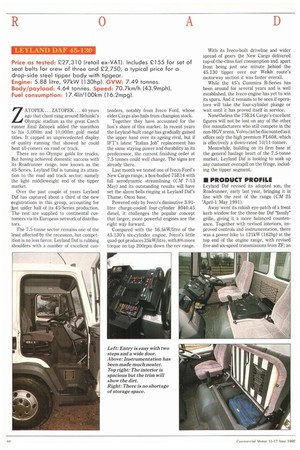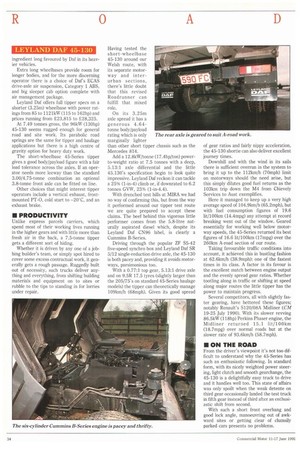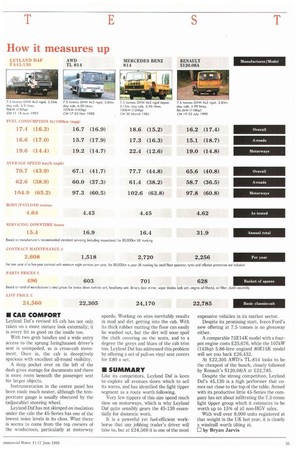LEYLAND DAF 45,130
Page 34

Page 36

Page 37

If you've noticed an error in this article please click here to report it so we can fix it.
Price as tested: 227,310 (retail ex-VAT). Includes £155 for set of seat belts for crew of three and 22,750, a typical price for a drop-side steel tipper body with tipgear.
Engine: 5.88 litre, 97kW (130hp), GVW: 7.49 tonnes. Body/payload: 4.64 tonnes. Speed: 70.7km/h (43.9mph).
Fuel consumption: 17.41it/100km (16.2mpg).
ZATOPEK ... ZATOPEK ... 40 years ago that chant rang around Helsinki's Olympic stadium as the great Czech runner Emil Zatopek added the marathon to his 5,000m and 10,000m gold medal titles. It capped an unprecedented display of quality running that showed he could beat all-comers on road or track.
There are no Olympic golds for trucks. But having achieved domestic success with its Roadrunner range, now known as the 45-Series, Leyland Daf is turning its attention to the road and track sector; namely the light middleweight end of the tipper market.
Over the past couple of years Leyland Daf has captured about a third of the new registrations in this group, accounting for just under half of its 45-Series production. The rest are supplied to continental customers via its European network of distributors.
The 7.-tonne sector remains one of the least affected by the recession, but competition is no less fierce. Leyland Daf is rubbing shoulders with a number of excellent con tenders, notably from Iveco Ford, whose elder Cargo also hails from champion stock.
Together they have accounted for the lion's share of this market. In recent years the Leyland-built range has gradually gained the upper hand over its ageing rival, but if IFT's latest "Italian Job" replacement has the same staying power and durability as its predecessor, the current finishing order at 7.5 tonnes could well change. The signs are already there.
Last month we tested one of Iveco Ford's New Cargo range, a box-bodied 75E14 with full aerodynamic streamlining (CM 7-13 May) and its outstanding results will have set the alarm bells ringing at Leyland Daf's Thame, Oxon base.
Powered only by Iveco's diminutive 3.91litre charge-cooled four-cylinder 8040.45 diesel, it challenges the popular concept that larger, more powerful engines are the right way forward.
Compared with the 16.5kW/litre of the 45.130's six-cylinder engine, Iveco's little quad-pot produces 25kW/litre, with 8% more torque on tap 200rpm down the rev range. With its Iveco-built driveline and wider spread of gears the New Cargo delivered top-of-the-class fuel consumption and, apart from being just one minute behind the 45.130 tipper over our Welsh route's motorway section it was faster overall.
While the 45's Cummins B-Series has been around for several years and is well established, the lveco engine has yet to win its spurs. And it remains to be seen if operators will take the four-cylinder plunge or wait until it has proved itself in service.
Nonetheless the 75E14 Cargo's excellent figures will not be lost on any of the other five manufacturers who still compete in the non-HGV arena. Volvo can be discounted as it offers only the high premium FL608, which is effectively a down-rated 10/11-tonner.
Meanwhile, building on its firm base at the general haulage heart of the 7.5-tonne market, Leyland Daf is looking to soak up any customer overspill on the fringe, including the tipper segment.
• PRODUCT PROFILE
Leyland Daf revised its adopted son, the Roadrunner, early last year, bringing it in line with the rest of the range (CM 25 'April-1 May 1991).
Away went its rakish eye-patch of a front kerb window for the three-bar Daf "family" grille, giving it a more balanced countenance. Together with revised interiors, improved controls and instrumentation, there was a power hike to 121kW (162hp) at the top end of the engine range, with revised five and six-speed transmissions from ZF; an
ingredient long favoured by Daf in its heavier vehicles.
Extra long wheelbases provide room for longer bodies, and for the more discerning operator there is a choice of Daf's ECAS drive-axle air suspension, Category 1 ABS, and big sleeper cab option complete with air management package.
Leyland Daf offers full tipper specs on a shorter (3.25m) wheelbase with power ratings from 85 to 1121kW (115 to 162hp) and prices running from £23,815 to £28,325.
At 7.49 tonnes gross, the 96kW (130hp) 45-130 seems rugged enough for general road and site work. Its parabolic road springs are the same for tipper and haulage applications but there is a high centre of gravity option for heavy duty work.
The short-wheelbase 45-Series tipper gives a good body/payload figure with a fair load tolerance across the axles. If an operator needs more leeway than the standard 3.00/4.75-tonne combination an optional 3.8-tonne front axle can be fitted on line.
Other choices that might interest tipper operators include a vertical exhaust, frontmounted PT-0, cold start to -20`C, and an exhaust brake.
• PRODUCTIVITY
Unlike express parcels carriers, which spend most of their working lives running in the higher gears and with little more than fresh air in the back, a 7.5-tonne tipper gets a different sort of hiding.
Whether it is driven by any one of a jobbing builder's team, or simply spot hired to cover some excess contractual work, it generally gets a rough passage. Ruggedly built out of necessity, such trucks deliver anything and everything, from shifting building materials and equipment on to sites or rubble to the tips to standing in for lorries under repair. Having tested the short-wheelbase 45-130 around our Welsh route, with its separate motorway and interurban sections, there's little doubt that this revised Roadrunner can fulfill that mixed role.
On its 3.25m axle spread it has a generous 4.64tonne body/payload rating which is only marginally lighter than other short tipper chassis such as the Mercedes 814.
Add a 12.8kW/tonne (17.4hp/ton) powerto-weight ratio at 7.5 tonnes with a deep, 5.13:1 axle differential and the little 45.130's specification begin to look quite impressive. Leyland Daf reckon it can tackle a 25% (1-in-4) climb or, if downrated to 6.2 tonnes GVW, 23% (1-in-4.4).
With drenched test hills at MIRA we had no way of confirming this, but from the way it performed around our tipper test route we are quite prepared to accept these claims. The beef behind this vigorous little performer comes from the 5.8-litre naturally aspirated diesel which, despite its Leyland Daf CN96 label, is clearly a Cummins B-Series.
Driving through the popular ZE S5-42 five-speed synchro box and Leyland Daf SR 5/12 single-reduction drive axle, the 45-130 is both pacey and, providing it avoids motorways, parsimonious too.
With a 0.77:1 top gear, 5.13:1 drive axle and on 9.5R 17,5 tyres (slightly larger than the 205/75's on standard 45-Series haulage models) the tipper can theoretically manage 109km/h (68mph). Given its good spread of gear ratios and fairly nippy acceleration, the 45-130 shortie can also deliver excellent journey times.
Downhill and with the wind in its sails there is sufficient overrun in the system to bring it up to the 112km/h (70mph) limit on motorways should the need arise, but this simply dilutes good fuel returns as the 103km trip down the M4 from Chievely Services to Aust exemplifies.
Here it managed to keep up a very high average speed of 104.9km/h (65.2mph), but with fuel consumption figures of 19.6 lit/100km (14.4mpg) any attempt at record breaking went out of the window. Geared essentially for working well below motorway speeds, the 45-Series returned its best figures of 16.6 lit/100km (17mpg) over the 260km A-road section of our route.
Taking favourable traffic conditions into account, it achieved this in bustling fashion at 62.6km/h (38.9mph): one of the fastest times in its class. A factor in its favour is the excellent match between engine output and the evenly spread gear ratios. Whether tootling along in traffic or shifting at speed along major routes the little tipper has the power to maintain progress.
Several competitors, all with slightly faster gearing, have bettered these figures; notably Renault's S120/08A Midliner (CM 19-25 July 1990). With its slower revving 86.5kW (118hp) Perkins Phaser engine, the Midliner returned 15.1 lit/100km (18.7mpg) over normal roads but at the slower rate of 93.6km/h (58.7mph).
• ON THE ROAD
From the driver's viewpoint it's not too difficult to understand why the 45-Series has such an enthusiastic following. In standard form, with its nicely weighted power steering, light clutch and smooth gearchange, the 45-130 is a delightfully easy truck to drive and it handles well too. This state of affairs was only spoilt when the weak detente on third gear occasionally landed the test truck in fifth gear instead of third after an enthusiastic shift from second.
With such a short front overhang and good lock angle, manoeuvring out of awkward sites or getting clear of clumsily parked cars presents no problems.
• CAB COMFORT
Leyland Daf's revised 45 cab has not only taken on a more mature look externally; it is every bit as good on the inside too.
With two grab handles and a wide entry access to the sprung Isringhausen driver's seat is unimpeded, as is cross-cab movement. Once in, the cab is deceptively spacious with excellent all-round visibility.
A deep pocket over on the left of the dash gives storage for documents and there is more room beneath the passenger seat for larger objects.
Instrumentation in the centre panel has been made much neater, although the temperature gauge is usually obscured by the (adjustable) steering wheel.
Leyland Daf has not skimped on insulation under the cab: the 45-Series has one of the lowest noise levels in its class. What there is seems to come from the top corners of the windscreen, particularly at motorway speeds. Working on sites inevitably results in mud and dirt getting into the cab. With its thick rubber matting the floor can easily be washed out, but the dirt will soon spoil the cloth covering on the seats, and to a degree the greys and blues of the cab trim too. Leyland Daf has addressed this problem by offering a set of pull-on vinyl seat covers for £80 a set.
• SUMMARY
Like its competitors, Leyland Daf is keen to explore all avenues down which to sell its wares, and has identified the light tipper segment as a route worth following.
Very few tippers of this size spend much time on motorways, which is why Leyland Daf quite sensibly gears the 45-130 essentially for domestic work.
It is a powerful yet fuel-efficient workhorse that any jobbing trader's driver will take to, but at £24,560 it is one of the most expensive vehicles in its market sector.
Despite its promising start, Iveco Ford's new offering at 7.5 tonnes is no giveaway either.
A comparable 75E14K model with a fourpot engine costs £25,676, while the 107kW (143hp) 5.86-litre engined 80E15K model will set you back £26,432.
At £22,305 AWD's TL-814 looks to be the cheapest of the bunch, closely followed by Renault's S120.08/A at £22,785.
Despite the strong competition, Leyland Dots 45.130 is a high performer that comes out close to the top of the table. Armed with its productive little 45-Series the company has set about infiltrating the 7.5-tonne light tipper group which it estimates to be worth up to 15% of all non-HGV sales.
With well over 9,000 units registered at that weight in the UK last year, it is clearly a windmill worth tilting at.
by Bryan Jarvis
















































































